The effects of TMAO and urea on the rate of labeling of sulfhydryl groups of glutamate dehydrogenase by the reagent 4-chloro-7-nitrobenzofurazan (Nbf-Cl). Control mixtures had neither TMAO nor urea. The structures of TMAO and urea are shown to the right of the graph. Credit: Marine Life Science & Technology (2022). DOI: 10.1007/s42995-022-00140-3
A set of abiotic stressors pose multiple challenges to marine life due to their widespread influence on all classes of biochemical systems. Variations in temperature, hydrostatic pressure, and salinity have potential to disrupt structures and functions of all molecular systems on which life depends. In an article published in Marine Life Science & Technology, Professor Somero focuses largely on one class of stressor effects that challenges the performance of all types of large molecular systems: proteins, nucleic acids and lipoprotein membranes.
The perturbing effects of these stressors at the biochemical level often result from their potential to disrupt the fine balance that is needed between stability and flexibility of the higher-order structures of these large molecular systems, which are stabilized largely by non-covalent (weak) chemical bonds like hydrogen bonds, ionic interactions, and hydrophobic effects. Importantly, all macromolecular systems of a cell must strike this balance between flexibility and stability if an organism's physiology is to function optimally.
This physiologically important balance between stability and flexibility of structure in large molecular systems is achieved in two principal manners. First, during evolution, the abiotic conditions that an organism faces lead to genetically based adaptations in the conformational stabilities of proteins and certain types of nucleic acids, and differences in lipid compositions. These intrinsic adaptations denote that they are encoded in the genome of the organism. Second, complementing these intrinsic, sequence-based adaptations in macromolecular structure are alterations in the chemical compositions—the "micromolecular contents"—of biological solutions that bathe macromolecules and influence their stabilities and functions. Small organic solutes—organic osmolytes—play central roles in these adaptive responses. These extrinsic adaptations due to osmolytes facilitate the retention of the evolved differences in macromolecular stability under different environmental conditions.
The article develops a parallel analysis between adaptive responses to two important physical stressors of the oceans, temperature and hydrostatic pressure. For both stressors, intrinsic and extrinsic adaptive changes are vitally important. The analysis focuses on the following two questions to discuss the adaptive changes in osmolyte systems. First, does the macromolecular stabilizing power of the intracellular osmolyte pool vary with evolutionary adaptation temperature (or pressure) and with the recent thermal (or pressure) exposure of the organisms (acclimatization effects)? Second, in modulating the stabilizing power of the osmolyte pool, do adaptive changes involve alterations in the types of osmolytes used, changes in their absolute or relative concentrations, or a combination of both of these strategies?
The range of environmental tolerance of a species may depend on how effectively the osmolyte composition of its cellular fluid can be altered in the face of stress. The study draws the following four main conclusions: First, in most marine organisms, organic osmolytes can maintain (or restore) the optimal balance of macromolecular rigidity and flexibility, which is a biological key to the optimal function of macromolecules. Second, adaptive changes in the composition and concentration of the osmolyte pool may have effects on macromolecules and biofilm systems and play an important role in establishing the optimal environmental tolerance of organisms. Third, stabilizing osmolytes vary greatly in how effectively they enhance the stability of macromolecules. Fourth, the ability of osmolyte systems to fine-tune the stabilization potential of cellular fluids in the face of body temperature (or pressure) changes that occur over different time periods may help organisms withstand effects of environmental change, notably the changes in temperature occurring due to global warming.
This article not only offers marine biologists important new information on how marine life adapts to the abiotic stressors of the sea, but these investigations also teach physical biochemists critical things about the physics of water-solute interactions and, for the technologically minded, suggest new strategies for developing solutions that aid in the stabilization and preservation of biological materials.
More information: George N. Somero, Solutions: how adaptive changes in cellular fluids enable marine life to cope with abiotic stressors, Marine Life Science & Technology (2022). DOI: 10.1007/s42995-022-00140-3
Provided by Compuscript Ltd























